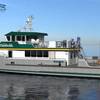New Ship Orders Slow Through 2012
The world fleet of dry bulk and general cargo vessels is expected to continue growing through 2012, in spite of weak freight rates and general overcapacity of tonnage, as new ships on order are delivered from shipyards, according to the latest Shipbuilding Market Forecast from Lloyd’s Register - Fairplay Research.
While scrapping of existing ships will also increase, it will not be sufficient to offset the massive influx of new ships, resulting in a net growth of tonnage in most segments of this market, which includes dry bulk carriers, general cargo ships, refrigerated cargo ships and dry cargo barges. The report notes that much of the current capacity consists of relatively new tonnage with plenty of years left in their service life, thereby slowing the removals to the scrap yards.
The newbuilding orderbook for dry bulk carriers now comprises 3,359 ships totaling 292 million deadweight tons (dwt), equal to 70 percent of existing fleet capacity. Even though bulk ship orders are highly exposed to cancellations and delayed delivery, this is accounted for in the forecast. “Even if deliveries are to be cut by half, bulk supply growth is still expected to outpace demand growth in 2009 and 2010, which will affect freight rate development trends negatively,” said Niklas Bengtsson, project manager and senior consultant, Lloyd’s Register - Fairplay Research.
Likewise, the general cargo segment is expected to continue growing at 3.5 percent annually through 2012. As in the dry bulk segment, when older ships are replaced, the new ones tend to be substantially larger in capacity due to the economies of scale.
Although demand for refrigerated cargo remains relatively strong, the specialised reefer fleet continues a path of slow decline as shipments are increasingly migrating to refrigerated containers. In 2008, only seven reefer ships were delivered, while 39 were removed.
In spite of the current overcapacity and depressed freight rates, the report cites the underlying strength of world demand for seaborne deliveries of bulk commodities such as coal, bauxite, iron ore and grain. The authors note that massive government spending on infrastructure improvements will stimulate increased demand for steel in 2009 and 2010.
Through 2012, orders will continue to be placed for new bulker and general cargo vessels, albeit at a slower pace from the ordering binge of 2007. In the general cargo segment, for instance, the forecast calls for a healthy 16.4 million dwt in new orders during that period, 35 percent less than in 2003-2007 but nonetheless respectable.
Overall, China still dominates the shipbuilding scene for bulkers and general cargo ships with 47 percent of the ships currently on order, followed by Japan with 19 percent and South Korea with 11 percent.
(www.lrfairplay.com)
















